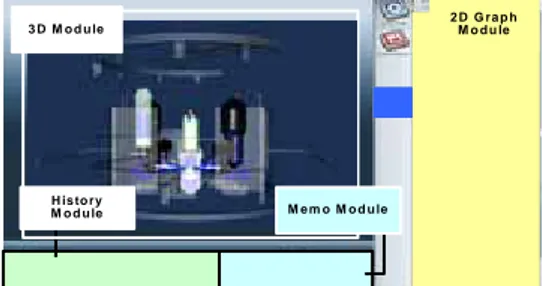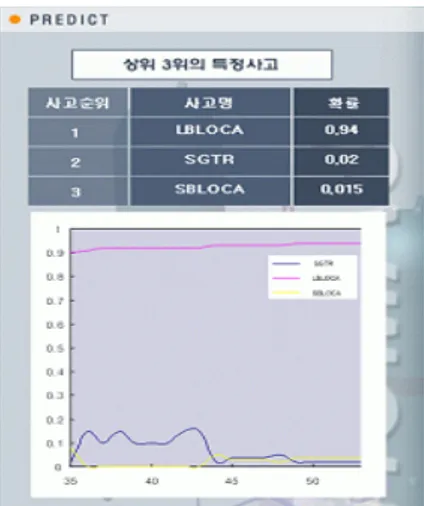Safety Performance Improvement for Nuclear Power Plants
Using THOMAS and Accident Prediction Function
Kyungmin Kanga, Namchul Choa, Moosung Jae*a, Kune Y. Suhb
a Department of Nuclear Engineering, Hanyang University, 17 Haengdang, Sungdong, Seoul, Korea b Department of Nuclear Engineering, Seoul National University, San 56-1 Sillim, Gwanak, Seoul, Korea
1. Introduction
The environments of nuclear industry are changed by incoming of digital technology. Until now, the nuclear power plant was adhering to analogue system in the large part of system. However the reliability of digital technology is increased, the adopting of digital technology is accelerated in the nuclear industry. It is not exception of the part of monitoring system. Digital-based thermal hydraulics online monitoring advisory system of nuclear power plant, as called THOMAS, which is can be developed economically compared with existing monitoring system is used for the decision making tool in the accident condition. We selected the Ulchin 3&4 units which is the type of Korea Standard Nuclear Power Plant(KSNP) as reference plant.
For nuclear power plants, EOPs (Emergency Operating Procedures) help operators to diagnose and analyze accidents. But it is very difficult that operators diagnose and analyze similar accidents with EOPs in a given short time. There are also possibilities to follow wrong procedures due to complex and extensive procedures. Therefore, it is important to develop a methodology for diagnosing accidents in a short time and reduction of human errors that made by complex signals and indicators.
THOMAS has a function of decision making using influence diagram logic. The influence diagram logic is based on total probability and Bayesian theory. And also the accident modeling is based on emergency operating procedure(EOP). The final goal of this system is, in the accident situation, to present the success path to the operator for the recovery of system. In this paper, at first, we will deal briefly with total system of THOMAS. And then 3D visualized window and accident prediction function will be introduced in detail.
II. Total System
THOMAS is not whole monitoring system, but only advisory system. Therefore its main functions only include the Reactor Coolant System (RCS) and the Emergency Core Cooling System (ECCS). The expressed variables are only 76. Some variables are THOMAS is independent on the main monitoring system of nuclear power plant. selected by nuclear thermodynamic system code analysis and the others are selected by expert’s advice. The most important characteristic of THOMAS, in the point of system design concept view, is convenience of the installation and expansion.
2.1 3D visualized window
At recent, delivery of information is not limited to the form of text. Generally, human can easily achieve the information form the data when the information includes the figure or animation. Already, other industry used multimedia for the discussion. Even, recently, army adopts the training which uses the multimedia, such as flash. In other words, text is not enough to effectively transmit the information. Therefore it is need to apply visualization technology for complicated system such as monitoring system of nuclear power plant. We tried to apply this change of environments for THOMAS, and the result is 3D visualized window. And THOMAS supports operator for the function which is the accident sequence using the 3D animation. The total number of supported sequence animation is 26 from Large Break Loss of Coolant Accident (LOCA) to trip of turbine. Human being has limit memory span which means storage capacity of short-term memory. In other words, memory span refers to the number of items, usually words or digits, that a person can hold in working memory. Generally, the average span for normal adults is 7±2. Therefore, one can observe only 9 safety parameters in one window of THOMAS.
3D Visualized Window module does not include only 3D module but also 2D module for purpose. In other words, 2D graph is used to confirm the trend of each safety parameters. From the current, previous 20 point and present value is draw for selected safety parameters in the X-Y plane. And also, if the guideline exist for each parameter, it is expressed in the same graph. Therefore the 3D Visualized Window that includes the previously referred functions is such as figure 1.
Figure 1. 3D Visualized Window
2.2 Accident Prediction Function
2 D G r a p h M o d u le H is t o r y M o d u le 3 D M o d u le M e m o M o d u le
Transactions of the Korean Nuclear Society Autumn Meeting Busan, Korea, October 27-28, 2005
Accident Prediction Function is based on the Emergency Operating Procedure(EOP) which applies balanced management to operator for mitigation of accident. Especially, optimal recovery guideline is applied when the type of accident is former. However, in real accident condition, it is not enough to guarantee the safety of nuclear power plant. Therefore it is needful to predict the type of accident as soon as possible for using some tool. In the THOMAS, Accident Prediction Function module performs that function.
Accident model of this module is based on EOP and its decision making algorithm is influence diagram which networks is composed of node and arc such as Eqs(1~2). The node has information and condition of the dependency.
Bayesian operation in Influence Diagrams model is,
( ) ( ) ( ) ( ) ( ) ( ) ( | ) ( ) ( ) P AE P A P E A P E P A E P E A P A E P A P E = = =
(1) where, (p A E : Posterior ) p A( ) : Prior ( ) ( ) p E A p E : Likelihood of Evidence
∫
− × = N j j j j j j A P A E L A E L A P E A P 1 ) ( ) | ( ) | ( ) ( ) | ( (2) The total probability and Bayesian theory is used for the quantity calculation of the influence diagram. Firstly, measurement node is absorbed into the symptom node by calculating total probability theory using given PSA data of sensor. Lastly, total probability theory is used once more to determine the accident which coincides with given symptom.At present, user can only select 3 types of symptom which are increase, decrease, changeless state about given safety parameters. However, it is difficult to apply this method for real nuclear power plant because each symptom of accident is able to very rapidly change during short time. For example, during SGTR, the steam generator pressure is perturbed. Therefore it is important to choose the base line for type of symptom. In this research, it is selected by result of nuclear system codes such as RELAP and RETRAN. And the advices of experts are also one of method for choosing the base line.
In the accident prediction function module, the numbers of safety parameters are only twelve until and final parameters will be limited below fifteen things for improving the operating rate. And Active Server Page(ASP) and Visual Basic(VB) languages are used for translating this algorithm into THOMAS. The real form of Accident Prediction Function module in THOMAS is like as figure 2 and it supports the function of trend graph for user.
Figure 2. Accident Prediction Function
3. Conclusion
3D visualized window and accident prediction function as advisory monitoring system of nuclear power plant. It is different points as comparison with existing domestic and foreign systems. Two modules has mutual dependency because the latter module predicts the accident and corresponding symptom is checked with the former. We are concentrating out efforts on the development of prototype which connects database with 3D object and models the accident to apply influence diagram about SGTR and SBLOCA.
It is shown that the accident prediction function might help operators have enough reaction time and select the appropriate procedure to prevent or mitigate accidents that may occur during normal operation. Some accidents such as SLOCA and SGTR applied in this study have similar symptoms and it is very important to diagnose them correctly.
REFERENCES
[1] Korea Electric Power Corporation, “Ulchin 3&4 Emergency Operating Procedure”
[2] I. S. Lee, S.H.Yoon, K.Y.Suh, “Advanced Operating Technique Using the VR Database System,” International Conference on Global Environment and Advanced Nuclear Power Plants GENES4/ANS2003, Kyoto, Japan, 2003.
[3] Moosung Jae, George E. Apostolakis, "The Use of Influence Diagrams for Evaluating Severe Accident Management Strategies", Nuclear Technology, vol.99, No.2, pp. 142-157, 1992.
[4] S. Holzman, Intelligent Decision Systems, Addison-Wesley, New York, 1999.
[5] R.D. Shachter, “Evaluating Influence Diagrams,” Operational Research, Vol. 34, No. 6, pp. 871, 1996.

